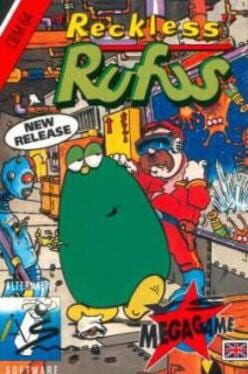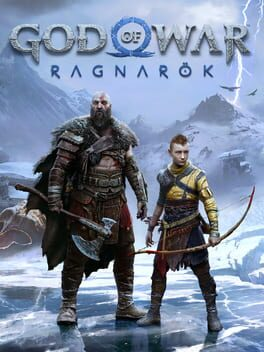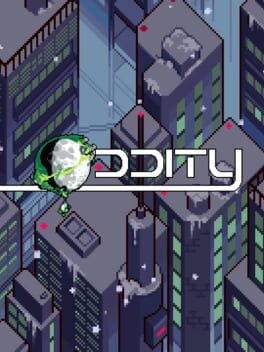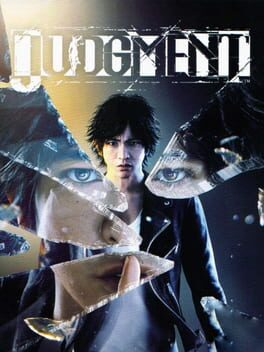Trivia Browser

▲
1
▼
Reckless Rufus was originally titled Awesome Dude, but Alternative Software decided to go with the former name instead.

▲
1
▼
A side quest called "The Ballad of Jari and Somr" was made as a tribute to two devs that met and fell in love while working at Santa Monica Studios, Jake Snipes and Sam Handrick. This quest involves going to The Eternal Campfire to unlock it and then searching for ingredients to prepare a meal, an homage to the couples love of making meals together. The unfortunate catalyst for this addition to the game was the death of Jake Snipes in 2020.
IGN guide:
https://www.ign.com/wikis/god-of-war-ragnarok/Across_the_Realms#Find_the_Prongfruit_.28Svartalfheim.29
Sam Handrick tweet:
https://twitter.com/MDSVeritas/status/1593439856226488321
God of War: Ragnarok - 12 Important Easter Eggs and References:
https://www.youtube.com/watch?v=DfN-CXjvbz8?t=703
https://www.ign.com/wikis/god-of-war-ragnarok/Across_the_Realms#Find_the_Prongfruit_.28Svartalfheim.29
Sam Handrick tweet:
https://twitter.com/MDSVeritas/status/1593439856226488321
God of War: Ragnarok - 12 Important Easter Eggs and References:
https://www.youtube.com/watch?v=DfN-CXjvbz8?t=703
Franchise: Donkey Kong
▲
3
▼
 Dutch electronics company Philips planned to release a Donkey Kong game for the CD-i as part of the deal with Nintendo that led to the release of Hotel Mario, Link: The Faces of Evil, Zelda: The Wand of Gamelon, and Zelda's Adventure. The Donkey Kong game's existence was alluded to in two "Gaming Gossip" articles by Electronic Gaming Monthly as well as a trade ad which depicted Donkey Kong exiting a limousine alongside Mario, Link, and Zelda. However, more concrete evidence for the game's existence didn't emerge until former Riedel Software Productions employee Adrian Jackson-Jones included a post on his LinkedIn page stating that he programmed the engine for it (the LinkedIn post incorrectly cites Australian visual effects studio Rising Sun Pictures due to them sharing initials). This information was then brought to public attention in 2022 by the LostMediaWiki, a website which documents searches for lost or otherwise publicly unavailable works.
Dutch electronics company Philips planned to release a Donkey Kong game for the CD-i as part of the deal with Nintendo that led to the release of Hotel Mario, Link: The Faces of Evil, Zelda: The Wand of Gamelon, and Zelda's Adventure. The Donkey Kong game's existence was alluded to in two "Gaming Gossip" articles by Electronic Gaming Monthly as well as a trade ad which depicted Donkey Kong exiting a limousine alongside Mario, Link, and Zelda. However, more concrete evidence for the game's existence didn't emerge until former Riedel Software Productions employee Adrian Jackson-Jones included a post on his LinkedIn page stating that he programmed the engine for it (the LinkedIn post incorrectly cites Australian visual effects studio Rising Sun Pictures due to them sharing initials). This information was then brought to public attention in 2022 by the LostMediaWiki, a website which documents searches for lost or otherwise publicly unavailable works.An investigation by Time Extension led to writer John Szczepaniak getting in contact with both Jackson-Jones and Riedel Software Productions owner Michael J. Riedel. Both parties have little memory of the Donkey Kong game due to the amount of time that passed and the company's habit of erasing their data for cancelled projects. Additionally, Jackson-Jones revealed that due to a memory disorder, he recalls little about the game other than his direct experiences programming it. Despite this, Jackson-Jones was able to confirm his involvement with the Donkey Kong game, stating that one of the biggest difficulties during development was the CD-i's memory limitations, which were circumvented by only loading in assets that would be visible on-screen, using the player's movement to determine what to put into memory.
Additional investigations by DidYouKnowGaming further revealed that the Donkey Kong CD-i game was intended to be a side-scrolling title similar to the later Donkey Kong Country series. According to an anonymous Riedel Software Productions employee who served as a lead animator for the game, development quickly stalled before June 1993, never making it past initial storyboards due to the CD-i's technical limitations and Philips' inexperience with the video game industry (contrary to Electronic Gaming Monthly's claims that it would be a sequel to the original arcade game and that it would be ready by 1994).
Time Extension article:
https://www.timeextension.com/features/like-zelda-and-mario-donkey-kong-was-supposed-to-get-a-philips-cd-i-game-what-happened
DidYouKnowGaming video:
https://www.youtube.com/watch?v=A7II7Xns3No
https://www.timeextension.com/features/like-zelda-and-mario-donkey-kong-was-supposed-to-get-a-philips-cd-i-game-what-happened
DidYouKnowGaming video:
https://www.youtube.com/watch?v=A7II7Xns3No
Franchise: Mario
▲
3
▼
 In the 2023 film "The Super Mario Bros. Movie", Mario and Luigi's family are prominently featured. This includes:
In the 2023 film "The Super Mario Bros. Movie", Mario and Luigi's family are prominently featured. This includes:• Their Father, voiced by Charles Martinet (and bears a resemblance to Talon from The Legend of Zelda: Ocarina of Time)
• Their Mother, who previously appeared in "The Super Mario Bros. Super Show!" and is voiced here by Jessica DiCicco
• Uncle Arthur, voiced by John DiMaggio
• Uncle Tony, voiced by Rino Romano (and was coincidentally mentioned in live-action segment "Glasnuts" from the TV series "The Super Mario Bros. Super Show!")
• Aunt Marie, who's presumably married to Uncle Arthur
• An unnamed niece, who's most likely Marie and Arthur's daughter, being a first cousin once removed that's referred to as a "(second) niece"
• An unnamed grandfather, who's implied by the co-director Aaron Horvath to previously have been a boxer and wears an outfit similar to Luigi in the 1983 commercial for the Atari ports of Mario Bros.
Interestingly, all of the credited voice actors for the family are all of Italian descent to stay true to the family's Italian heritage.
According to Shigeru Miyamoto, the design of the family were based on character design sheets that former Nintendo illustrator Yoichi Kotabe drew decades before the film began production.
Polygon article:
https://www.polygon.com/23673074/mario-movie-family-members-dad-mom-uncles-aunt
The Super Mario Bros. Movie - Family Dinner scene:
https://www.youtube.com/watch?v=W9S6M_l2FrE
The Super Mario Bros. Movie - End credits:
https://www.youtube.com/watch?v=GhM8c5sUhPg?t=239
Mario Bros. 1983 Atari commercial:
https://www.youtube.com/watch?v=dduvx-dEySY
https://www.polygon.com/23673074/mario-movie-family-members-dad-mom-uncles-aunt
The Super Mario Bros. Movie - Family Dinner scene:
https://www.youtube.com/watch?v=W9S6M_l2FrE
The Super Mario Bros. Movie - End credits:
https://www.youtube.com/watch?v=GhM8c5sUhPg?t=239
Mario Bros. 1983 Atari commercial:
https://www.youtube.com/watch?v=dduvx-dEySY

▲
1
▼
According to one of the game's tech leads Jack Mathews, the way the developers were able to keep the game at 60 FPS with four different visors was to make one visor the "baseline," and make sure the others perform as well or better, with tech or design:
• The baseline for all the other visors is the Combat Visor, which provides an unmolested view of the world. It has Samus' Arm Cannon, lightmaps, and allows for plenty of combat. In Mathews' opinion, it's the most beautiful visor, because it's the one the player sees the most.
• The Scan Visor has the baseline elements of the Combat Visor, plus more UI, markers, a zoom window, etc., but it doesn't have the Arm Cannon, projectiles, and their lights. All that performance goes to the visor, which is why everything seen through the scanning window has a low quality blur. According to Mathews, the design of the visor needed a slightly zoomed scan window, but they didn't have the performance to re-render everything or render at a higher resolution, so they just did a digital zoom which blurs things.
• The Thermal Visor does have combat and particles, so the visor's performance comes from the lack of static lightmaps. All world lighting is turned off, and the post-process filters are just a palette lookup. The palette used for the visor was created offline. "Hot" objects used the Z component of the screen-space normal. "Cold" objects used the red component of their albedo texture.
• The X-Ray Visor (created by programmer Ted Chauviere) also has combat and lets the player see through enemies and Samus' Arm Cannon. Everything else, while purported by the game to be see-through in the visor, is essentially the same, and "invisible" objects are just models turned on and off. They also rendered with a white-to-black "fog" so they don't need to render far-away objects, and it's rendered at a lower resolution and blurred. The details of how this fog works involves obscuring the main view and showing depth buffer and normals/normalmaps only (with some trickery for invisible objects), but according to Mathews converting the GameCube depth buffer to something linear on the GPU was extremely expensive, on top of there being no normal maps on the GameCube.
• The Morph Ball Camera also essentially works as a visor, but instead of gun and particles, world shadows are projected on the ball surface (this effect was created by fellow lead technical engineer Andy O'Neal), a projected shadow under the ball, and a constant dynamic light.
• The baseline for all the other visors is the Combat Visor, which provides an unmolested view of the world. It has Samus' Arm Cannon, lightmaps, and allows for plenty of combat. In Mathews' opinion, it's the most beautiful visor, because it's the one the player sees the most.
• The Scan Visor has the baseline elements of the Combat Visor, plus more UI, markers, a zoom window, etc., but it doesn't have the Arm Cannon, projectiles, and their lights. All that performance goes to the visor, which is why everything seen through the scanning window has a low quality blur. According to Mathews, the design of the visor needed a slightly zoomed scan window, but they didn't have the performance to re-render everything or render at a higher resolution, so they just did a digital zoom which blurs things.
• The Thermal Visor does have combat and particles, so the visor's performance comes from the lack of static lightmaps. All world lighting is turned off, and the post-process filters are just a palette lookup. The palette used for the visor was created offline. "Hot" objects used the Z component of the screen-space normal. "Cold" objects used the red component of their albedo texture.
• The X-Ray Visor (created by programmer Ted Chauviere) also has combat and lets the player see through enemies and Samus' Arm Cannon. Everything else, while purported by the game to be see-through in the visor, is essentially the same, and "invisible" objects are just models turned on and off. They also rendered with a white-to-black "fog" so they don't need to render far-away objects, and it's rendered at a lower resolution and blurred. The details of how this fog works involves obscuring the main view and showing depth buffer and normals/normalmaps only (with some trickery for invisible objects), but according to Mathews converting the GameCube depth buffer to something linear on the GPU was extremely expensive, on top of there being no normal maps on the GameCube.
• The Morph Ball Camera also essentially works as a visor, but instead of gun and particles, world shadows are projected on the ball surface (this effect was created by fellow lead technical engineer Andy O'Neal), a projected shadow under the ball, and a constant dynamic light.
Franchise: Kirby
▲
1
▼
In an interview with Polygon writer Chris Plante, series director Shinya Kumazaki stated that although Kirby appears to devour his enemies, the foes that he swallows are not killed; instead, they simply get "poofed" elsewhere in the world. According to Kumazaki, this concept is meant to make the series more approachable to lay audiences by presenting a comedic alternative to the "extreme or violent expression" of Kirby digesting his opponents.

subdirectory_arrow_right Yakuza: Like a Dragon (Game)
▲
2
▼
While the protagonist of Yakuza: Like a Dragon, Ichiban Kasuga, is commonly stated to have debuted in the 2018 game Ryu Ga Gotoku Online, he actually was first revealed in a trailer for the game Fist of the North Star: Lost Paradise, which is considered a spin-off of the Yakuza/Like a Dragon franchise. This trailer aired almost a year before Ryu Ga Gotoku Online and is notable as Ichiban does not appear in Fist of the North Star: Lost Paradise.

▲
1
▼
When you are locked onto a target in Metroid Prime, pressing the jump button does a sideways dash. This lets the player easily strafe around a target and dodge incoming fire. This sideways strafe jump sets a horizontal velocity on the player that continues to circle around the target while locked on, but if you unlock the target just as the strafe jump starts, Samus keeps the horizontal momentum without the lock-on pull. This trick, which the game's speedrunning community called the Scan Dash, allows for a larger horizontal distance traversal than a normal jump. Using this momentum can let Samus catch the edge of the cliff beside her ship in the Landing Site and get the Space Jump Boots early upon landing.
According to programmer Zoid Kirsch, creative use of the game physics and movement that results in acquiring items out of order allows for creative exploration of the game world. While sequence breaks like this are a crucial part of the Metroid series, this trick would actually be patched out in later releases of the game.
According to programmer Zoid Kirsch, creative use of the game physics and movement that results in acquiring items out of order allows for creative exploration of the game world. While sequence breaks like this are a crucial part of the Metroid series, this trick would actually be patched out in later releases of the game.
Zoid Kirsch tweet:
https://twitter.com/ZoidCTF/status/1592354759868313602
Metroid Prime speedrun wiki page on Scan Dash:
https://wiki.metroidprime.run/wiki/Scan_Dash_(Prime)
https://twitter.com/ZoidCTF/status/1592354759868313602
Metroid Prime speedrun wiki page on Scan Dash:
https://wiki.metroidprime.run/wiki/Scan_Dash_(Prime)

▲
1
▼
If Samus speeds through a Morph Ball puzzle or boosts through a Morph Ball tunnel, sometimes there's a little door blocking the way. According to programmer Zoid Kirsch, these doors were designed to resemble and serve the same purpose as the regular big doors that open once the force field over them is shot and the room behind them is fully loaded.
When they first started making the 2D-styled Morph Ball areas, they were connected to various rooms with tunnels. They worked well until testers started beating the load times of the next room and would fall out of the world. Kirsch had to go throughout the game and add the Morph Ball doors into every tunnel that crossed rooms to ensure that Samus won't roll out of the tunnel and fall into the void before the room is loaded. Because the testers were already conditioned to wait at the big doors after the force field was shot, no players ended up backtracking and waited for the small doors to open, rendering them a successful change. Ideally, players shouldn't see the small doors very often as the load system tries to get the next room loaded, but they might bump into them if they are quick enough.
When they first started making the 2D-styled Morph Ball areas, they were connected to various rooms with tunnels. They worked well until testers started beating the load times of the next room and would fall out of the world. Kirsch had to go throughout the game and add the Morph Ball doors into every tunnel that crossed rooms to ensure that Samus won't roll out of the tunnel and fall into the void before the room is loaded. Because the testers were already conditioned to wait at the big doors after the force field was shot, no players ended up backtracking and waited for the small doors to open, rendering them a successful change. Ideally, players shouldn't see the small doors very often as the load system tries to get the next room loaded, but they might bump into them if they are quick enough.

▲
1
▼
In the last few months of the game's development, the team invited friends of family to do "white paper" playtests of the game where they would play without help and the developers would monitor their progress. According to programmer Zoid Kirsch, they learned a lot from these observations:
These tests with new players helped improve the game greatly, because they provided clear feedback in how to communicate the game world to the player, resulting in a lot of simple design changes that were incorporated throughout the game.
"We'd often see testers get stuck in rooms that had [Morph Ball] tunnel exits--they won't notice them. This resulted in putting big spotlights over those entrances to make them stand out as a path. Our testers often couldn't figure out how to get up to the bridge leading to the Arboretum. After they acquired the [Morph Ball] and returned to the Main Plaza in the Chozo Ruins they didn't notice the steps in the back to cross the bridge. Originally both back steps were nearly the same color. We changed them to different textures and improved lighting. Our next set of testers noticed it immediately."
These tests with new players helped improve the game greatly, because they provided clear feedback in how to communicate the game world to the player, resulting in a lot of simple design changes that were incorporated throughout the game.

▲
1
▼
According to programmer Zoid Kirsch, when the team first started working on Phendrana Drifts in Metroid Prime, they created a particle system that shows snow gently falling. When the snow effect was first implemented, they noticed large empty streaks in the falling snow, and quickly realized that the snow was basically a 3D plot of the deficiency of the default random number generator that came with their compiler.
They switched to a using a better random algorithm via a linear congruential generator that was still fast, but generates a far better distribution of numbers, allowing the snow to look much more evenly distributed. This moment was what helped the developers realize just how bad their default random number generator was and that they had to make use of a better one.
When this story was originally posted to Twitter in 2022, several other developers replied with similar shorter anecdotes about working with RNG, such as Robin Lavallée, a programmer on Surf's Up for the Nintendo DS, and Tom Leonard, the lead programmer on Thief: The Dark Project.
They switched to a using a better random algorithm via a linear congruential generator that was still fast, but generates a far better distribution of numbers, allowing the snow to look much more evenly distributed. This moment was what helped the developers realize just how bad their default random number generator was and that they had to make use of a better one.
When this story was originally posted to Twitter in 2022, several other developers replied with similar shorter anecdotes about working with RNG, such as Robin Lavallée, a programmer on Surf's Up for the Nintendo DS, and Tom Leonard, the lead programmer on Thief: The Dark Project.
Zoid Kirsch tweet:
https://twitter.com/ZoidCTF/status/1591250996793315328
Robin Lavallée tweet:
https://twitter.com/robinlavallee/status/1592104617395257344
Tom Leonard tweet:
https://twitter.com/Zoobomb/status/1591281402141904897
https://twitter.com/ZoidCTF/status/1591250996793315328
Robin Lavallée tweet:
https://twitter.com/robinlavallee/status/1592104617395257344
Tom Leonard tweet:
https://twitter.com/Zoobomb/status/1591281402141904897

subdirectory_arrow_right Prince of Persia: The Forgotten Sands (Game)
▲
1
▼
According to programmer Zoid Kirsch, when he first started programming and learning BASIC, one of the first programs he wrote at the age of 13 was a maze generation algorithm that could generate a maze of any size with a single solution (a C code port of Kirsch's original BASIC implementation, posted by him on Usenet in 1989, is included in the self-source tab for this submission). During the development of Metroid Prime, when designing Central Dynamo, the room in the Phazon Mines with the Power Bomb upgrade, he used the same algorithm to add a randomly generated maze for the Morph Ball that players would have to solve.
One of the game's tech leads Jack Mathews expressed concern that this algorithm would eventually generate an impassible maze, so to ensure that the maze was of sufficient length, he wrote a tool that would generate and then solve the maze, picking 300 random seeds that the solver indicated at least 75% of the maze was required to be traversed. This results in 300 different mazes that can be generated in Central Dynamo. The maze also features two obstacles along the route in the form of water puddles that must be bombed to short out the nearby nodes and open the path.
When this story was originally posted to Twitter in 2022, programmer Robin Lavallée commented that he wrote a similar algorithm for the Wii game Prince of Persia: The Forgotten Sands, where all seeds were equally likely, and the solution would be stored as he built the maze.
One of the game's tech leads Jack Mathews expressed concern that this algorithm would eventually generate an impassible maze, so to ensure that the maze was of sufficient length, he wrote a tool that would generate and then solve the maze, picking 300 random seeds that the solver indicated at least 75% of the maze was required to be traversed. This results in 300 different mazes that can be generated in Central Dynamo. The maze also features two obstacles along the route in the form of water puddles that must be bombed to short out the nearby nodes and open the path.
When this story was originally posted to Twitter in 2022, programmer Robin Lavallée commented that he wrote a similar algorithm for the Wii game Prince of Persia: The Forgotten Sands, where all seeds were equally likely, and the solution would be stored as he built the maze.
Zoid Kirsch tweet:
https://twitter.com/ZoidCTF/status/1591122506806882304
C code port of Kirsch's original BASIC implementation, posted by him on Usenet in 1989:
https://groups.google.com/g/comp.lang.c/c/Uw2mgfSPtbI/m/SXmTt6_pCB8J
Jack Mathews tweet:
https://twitter.com/jack_mathews/status/1591155796695732224
Robin Lavallee tweet:
https://twitter.com/robinlavallee/status/1591141684012003331
More detailed explanation of how the maze works:
https://wiki.metroidprime.run/wiki/Central_Dynamo
https://twitter.com/ZoidCTF/status/1591122506806882304
C code port of Kirsch's original BASIC implementation, posted by him on Usenet in 1989:
https://groups.google.com/g/comp.lang.c/c/Uw2mgfSPtbI/m/SXmTt6_pCB8J
Jack Mathews tweet:
https://twitter.com/jack_mathews/status/1591155796695732224
Robin Lavallee tweet:
https://twitter.com/robinlavallee/status/1591141684012003331
More detailed explanation of how the maze works:
https://wiki.metroidprime.run/wiki/Central_Dynamo

▲
1
▼
According to programmer Zoid Kirsch, the reason why Metroid Prime had elevators were because, as a mainstay of the 2D Metroid series, they were used for three primary technical reasons that were also present in the series' first 3D game: world maps could only be up to a certain size, sound banks needed to be changed, and the transitions helped to clear up any memory fragmentation.
1. The world size limit was due to floating point precision. If Samus got too far from the origin, her movement would start stuttering since the values would get too large. When this story was originally posted to Twitter in 2022, Robin Lavallée, a former lead programmer at Ubisoft, suggested that Retro Studios could have shifted floating points where after a certain distance, everything would be shifted back closer to origin, citing this as something done during the development of Assassin's Creed IV: Black Flag. However, Kirsch replied back that the team deliberately avoided doing this out of concern that it would cause bugs. Instead, Samus moves consistently through the world as it loads around her.
2. For the sound banks, the MusyX sound system can stream music but it couldn’t for sound effects. Each world had a different set of sounds that were loaded while the elevator cut scene is running.
3. The GameCube doesn't have any virtual memory and everything is allocated from the physical RAM. The elevator loads caused all memory to be freed between the worlds, cleaning up any fragmentation.
One of the game's tech leads Jack Mathews hardcoded the different elevator cutscenes into the game. It's not a "room" at all, nor is it a prerendered video file, but it's coded directly in C++ and does not run through the usual game systems for camera control, etc. They also feature crossfades since it had fixed rendering, one of the only places the developers could afford to render overlapped scenes.
1. The world size limit was due to floating point precision. If Samus got too far from the origin, her movement would start stuttering since the values would get too large. When this story was originally posted to Twitter in 2022, Robin Lavallée, a former lead programmer at Ubisoft, suggested that Retro Studios could have shifted floating points where after a certain distance, everything would be shifted back closer to origin, citing this as something done during the development of Assassin's Creed IV: Black Flag. However, Kirsch replied back that the team deliberately avoided doing this out of concern that it would cause bugs. Instead, Samus moves consistently through the world as it loads around her.
2. For the sound banks, the MusyX sound system can stream music but it couldn’t for sound effects. Each world had a different set of sounds that were loaded while the elevator cut scene is running.
3. The GameCube doesn't have any virtual memory and everything is allocated from the physical RAM. The elevator loads caused all memory to be freed between the worlds, cleaning up any fragmentation.
One of the game's tech leads Jack Mathews hardcoded the different elevator cutscenes into the game. It's not a "room" at all, nor is it a prerendered video file, but it's coded directly in C++ and does not run through the usual game systems for camera control, etc. They also feature crossfades since it had fixed rendering, one of the only places the developers could afford to render overlapped scenes.

▲
1
▼
The geometric limb assets introduced in the episode "Insectophobe's Nightmare" from the webseries "Battle for Dream Island" were originally created for the cover art of this game.

▲
1
▼
The musician Raeb is voiced by the game's composer Bear McCreary. Not only is he voiced by Bear, but his face is similar and his name is an anagram for Bear.

▲
2
▼
According to one of the game's tech leads Jack Mathews, shortly after Metroid Prime shipped, Nintendo told Retro Studios that a "bad batch" of GameCube CPUs shipped, and apparently this game was the only game that misbehaved on them. Upon seeing videos of the issue, it became clear to them what was going on:
In retrospect, he wondered if it was possible to instead rig up the GameCube so it stayed in the freezer and let the wires run out to connect to the TV to save time running back and forth.
On the more technical side, Mathews explained:
When a player called Nintendo of America's support hotline about this animation problem, they would send them a new copy of the game disc with this updated code.
When this story was posted to Twitter in 2022, one user posted an older video of a graphics glitch positing that the issue is "caused by the ANCS file using the wrong CSKR for the suit model", and that it might be possible to simulate the issue outside of the hardware and software conditions it originally happened in. Mathews replied:
Mathews also talked about how it would have been a bigger hassle to rewrite the skinning pipeline to use the locked cache, because it would have been a rewrite by taking the risk of adding new code and may have net slowed things down. Adding the NOPs wouldn't break anything and just moved the stalls from the memory controller to the PPC chip.
"All animated objects were freaking out... we needed to actually slow down some of our code, because it was running too fast for these CPUs to handle! We needed to be able to test this, but Nintendo only had one dev kit with this CPU. We couldn't detect the CPU, and if we slowed it down too much, the game's framerate would tank. If we didn't slow it down enough, it would glitch. Even worse, we had to burn disks for this kit. So each test was hours. Even weirder was to see the problem, the kit had to be cold. Like, freezer cold. So we literally had to put the kit in the freezer, test the game for 15 minutes tops, then start all over. It was crazy. We literally were running the kit from the break room freezer to the TV, and loading save games as fast as possible to as many places as possible in 15 minutes, then trying new code, re-freezing, and back. I'll never forget it."
In retrospect, he wondered if it was possible to instead rig up the GameCube so it stayed in the freezer and let the wires run out to connect to the TV to save time running back and forth.
On the more technical side, Mathews explained:
"Our skinning used the locked cache DMA to read in data and the write gather pipeline to write it out. Most of the Nintendo samples used the locked cache for both read and write, so my method was a bit faster. But it also hit memory bandwidth limits. As I recall, the issue was that the write gather pipe on these broken CPU's wouldn't stall when it was full or properly report its status, so we had to keep inserting NOPs in the code to slow it down just enough to stop stalls from happening, but not so much to slow down the game."
When a player called Nintendo of America's support hotline about this animation problem, they would send them a new copy of the game disc with this updated code.
When this story was posted to Twitter in 2022, one user posted an older video of a graphics glitch positing that the issue is "caused by the ANCS file using the wrong CSKR for the suit model", and that it might be possible to simulate the issue outside of the hardware and software conditions it originally happened in. Mathews replied:
"I don't know if it was writing out less than we were putting in the write-gather, or throwing away and reusing from the buffer, but sort of along these lines, with more jittering and triangles all over the place. This example has coherent skinning, just a bad mapping... I think the WG pipe was a 96 byte circular buffer. So when it wouldn't stall, it would write bytes over earlier entries in the buffer before they could flush to main memory. These would still be four-byte aligned writes, so I think the way to emulate it would be to take blocks of anywhere from 4-32 bytes (a multiple of four) and move them back by 96 bytes in the skinning buffer."
Mathews also talked about how it would have been a bigger hassle to rewrite the skinning pipeline to use the locked cache, because it would have been a rewrite by taking the risk of adding new code and may have net slowed things down. Adding the NOPs wouldn't break anything and just moved the stalls from the memory controller to the PPC chip.
Jack Mathews tweet:
https://twitter.com/jack_mathews/status/1590748677160566786
Older video of a graphics glitch:
https://www.youtube.com/watch?v=5f-N9WUHJwE
https://twitter.com/jack_mathews/status/1590748677160566786
Older video of a graphics glitch:
https://www.youtube.com/watch?v=5f-N9WUHJwE

▲
1
▼
The size of Metroid Prime's save data is under ~60 bytes in size. According to programmer Zoid Kirsch, the reason why the save data is so tiny is because each room in the game has a set of "world layers" that define which objects spawn when the room is loaded (e.g. world layers change Flaahgra's room from having a boss to Chozo Ghosts and an Artifact when returning later). World layers are also used for items like Energy Tanks or Missile Expansions; when they are picked up, they are on a separate world layer that is disabled once the item is acquired. If that layer wasn't disabled, the item would be there the next time the room is loaded.
A world layer state is represented by a single bit in the save data, and since there are only a few hundred world layers in the whole game, it ends up requiring just under ~50 bytes to represent them all, with the remaining bytes in the save data representing health, missile count, etc. When Nintendo asked Retro Studios how many memory card blocks Metroid Prime was expected to take up, Kirsch said: "One!" A GameCube memory card block is 8 KB, which was much more space than needed to save the game.
A world layer state is represented by a single bit in the save data, and since there are only a few hundred world layers in the whole game, it ends up requiring just under ~50 bytes to represent them all, with the remaining bytes in the save data representing health, missile count, etc. When Nintendo asked Retro Studios how many memory card blocks Metroid Prime was expected to take up, Kirsch said: "One!" A GameCube memory card block is 8 KB, which was much more space than needed to save the game.

▲
1
▼
 To help development reach its finish, Retro Studios licensed out a PHP-based bug tracker called Mantis, working with Nintendo of America's product testing division to find bugs and the team's producers would enter bug reports.
To help development reach its finish, Retro Studios licensed out a PHP-based bug tracker called Mantis, working with Nintendo of America's product testing division to find bugs and the team's producers would enter bug reports.Eventually, Metroid Prime went gold on October 29, 2002 at 2:21 AM, less than a month before the release date to give time to manufacture game discs. Programmer Zoid Kirsch described it as one of the most memorable days of his life, commemorating it by getting the development team's signatures on a magazine poster. Notably, none of the developers signed on Samus because they had a large amount of respect for the character.
Zoid Kirsch tweet:
https://twitter.com/ZoidCTF/status/1590493890314129408
Mantis bug tracker:
https://www.mantisbt.org/
https://twitter.com/ZoidCTF/status/1590493890314129408
Mantis bug tracker:
https://www.mantisbt.org/

▲
2
▼
 Oddity started life as Mother 4, a fanmade sequel to the EarthBound trilogy, and was advertised as such in initial marketing. However, in 2017, the development team decided to rebrand the game following a wave of cease-and-desist notices against other high-profile Nintendo fangames.
Oddity started life as Mother 4, a fanmade sequel to the EarthBound trilogy, and was advertised as such in initial marketing. However, in 2017, the development team decided to rebrand the game following a wave of cease-and-desist notices against other high-profile Nintendo fangames.

